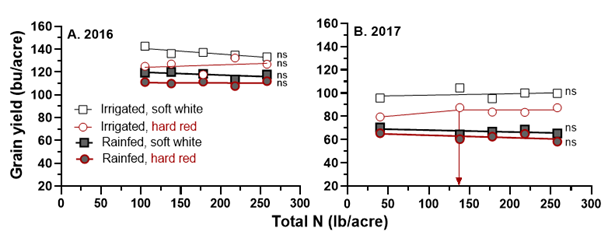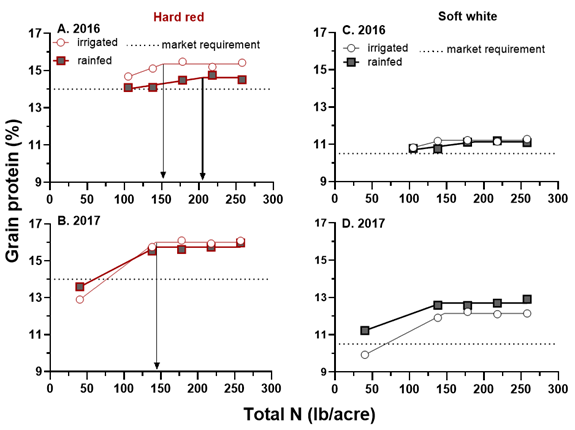Hard Red and Soft White Spring Wheat: Should they be fertilized differently?
A printable PDF version is available.
Breno Bicego1,2, Anish Sapkota1,3, Marilyn Dalen1, and Jessica Torrion1
1Northwestern Agricultural Research Center, Montana State University, Kalispell, MT
2Currently, Department of Agricultural and Forest Sciences and Engineering, University of Lleida – Agrotecnio-Cerca Center, Spain
3Currently, Land Resources and Environmental Sciences, Montana State University, Bozeman, MT
INTRODUCTION
Nitrogen (N) is generally an expensive farm input but is required to optimize wheat productivity. It is generally common to apply high rates of N to achieve high grain yield and high protein in hard red wheat grain (Diacono et al. 2013). The practice leads to economically risky production systems as the higher grain yields and protein often do not offset the cost of high N fertilizer rates (Bicego et al. 2019; Sadras & Lawson 2013). An option is to plant a different market class; hard red spring wheat has a minimum grain protein market requirement (14%), while soft white spring wheat has a maximum protein limit (10.5%), and hence lower N need. Protein greaterthan 10.5% in soft white is discounted at the elevator, reducing the incentive to apply too much N. We evaluated whether N rates should be different between hard red and soft white spring wheat under rainfed and irrigated conditions.
METHODS
This study was conducted in 2016 and 2017 in Creston, MT, on Flathead fine sandy loam under two environments: rainfed and irrigated. We grew spring wheat (hard red: Egan, McNeal, Solano, Vida; soft white: Alpowa, Alturas, Penewawa, and UI-Stone) under five total available N levels (control, 138, 178, 218 and 258 lb N/acre). Total available N is the sum of residual soil nitrate to 3-foot depth, mineralized soil N, applied N fertilizers, and N credit from prior crop (Table 1). Urea was broadcast before wheat was planted, incorporated using a cultivator, and the soil was packed. Irrigation was applied using overhead sprinklers.
|
Source of soil N
|
2016 (lb N/acre)
|
2017 (lb N/acre)
|
|---|---|---|
|
Residual nitrate-N to 3-foot depth
|
57
|
25
|
|
Soil organic matter
|
2.7%
|
2.5%
|
|
Mineralized N from soil organic matter
|
11
|
8
|
|
Prior crop N credit
|
Alfalfa = 30
|
Barley = 0
|
|
Irrigation water
|
0
|
0
|
|
Monoammonium phosphate (MAP)
|
7
|
7
|
|
Total soil N in the control
|
105
|
40
|
|
Total soil N with MAP and urea for the increased N treatments
|
138, 178, 218 and 258
|
|
RESULTS
Grain Yield
Over the two years, only the irrigated hard red wheat in 2017 had increased grain yields with increased available soil N, with an optimal total soil N of 138 lb N/acre (Fig. 1A, 1B). In 2017, there was low total soil N (40 lb/acre) and it was hot and dry, resulting in lower average grain yields than in 2016. In 2016, there was higher total soil N (105 lb/acre), and it was cooler and wetter resulting in greater yields overall; however, additional N did not increase yield (Fig. 1A). Irrigation increased yields in both years. The soft white market class had generally greater grain yields than the hard red, although there was less difference between the market classes in the hot, dry year (2017), specifically under rainfed conditions.

Figure 1. Grain yields in 2016 (A) and 2017 (B) of hard red and soft white spring wheat to total N (residual nitrate to 3-foot depth, mineralized N, applied fertilizer N, and in 2016 a 30 lb N/acre alfalfa credit). Downward arrow is the total N level that maximized grain yield under the irrigated environment in 2017. ns, non-significant N effect with 95% probability.
Grain Protein
As expected, higher N levels were needed to increase grain protein than yield in both market classes (Fig. 2). Hard red wheat grain protein reached 14% at 100 lb N/acre under both rainfed and irrigated conditions in both the cool-wet, and the hot-dry year (Fig. 2A, B). Protein increased further with N above that level, without an increase in yields (Fig. 1A). During the cool, wet year (2016), protein plateaued at 152 lb total N/acre under irrigation and 205 lb N/acre under rainfed conditions. Grain protein did not increase with N above those levels.
The rainfed wheat had a 30-35% greater N requirement than the irrigated to reach maximum protein. However, increasing N by 30% only increased protein by 0.5 protein points. The protein premium in hard red wheat may not be sufficient to justify this additional N under average rainfed growing conditions. Under hot, dry conditions (2017), hard red wheat, even with irrigation, only required 145 lb N/acre to achieve maximum grain protein. In our region, minimizing N application in hard red spring wheat to reach total soil N of 150 lb/acre minimizes economic risk.
Soft white spring wheat with protein greater than 10.5% is discounted at the elevator, so the goal is grain protein slightly below that level. During a cool, wet year like 2016, more than 100 lb/acre total N resulted in a grain protein greater than the critical market requirement (Fig. 2C). In the hot, dry year, soft white spring wheat grain protein exceeded the 10.5% level at 50 lb N/acre under rainfed conditions and at around 70 lb N/acre with irrigation (Fig. 2D). Since drought is hard to predict, high protein is penalized, and yield did not increase with higher soil N, lower N applications for soft white wheat would increase profitability.

Figure 2. Grain protein responses for hard red in 2016 (A) and 2017 (B) and for soft white in 2016 (C) and 2017 (D) to the total soil N (residual nitrate to 3-foot depth, mineralized N, applied fertilizer N, and in 2016 a 30 lb N/acre alfalfa credit). Downward arrows are N level that maximized protein in hard red spring wheat. Dotted line is hard red’s minimum- and soft white’s maximum grain protein market requirement.
FERTILIZER FACTS
- Grain yield did not increase with total N (residual nitrate to 3-foot depth, mineralized N, applied fertilizer N, and N credit from alfalfa in 2016) greater than 100 lb N/acre in a cool, wet year. In a hot, dry year, yields did not increase with total available N above 50 lb N/acre, except hard red spring wheat under irrigation which had maximum yields at 138 lb N/acre.
- Hard red spring wheat reached 14% protein with 100 lb N/acre of total available N.
- In our region, for soft white wheat, 90 lb/acre total N was sufficient in wet years for yield and kept protein below 10.5%. In hot, dry years, total N could be cut back to 50 to 70 lb N/acre.
- Soft white spring wheat required two-thirds of the total N required by hard red spring wheat for optimal grain yield and to keep protein below 10.5%.
ACKNOWLEDGMENTS
We thank the Montana Agricultural Experiment Station and Montana Fertilizer Advisory Committee for the funding support on this project.
REFERENCES
Bicego, B., Sapkota, A., & Torrion, J. A. (2019). Differential nitrogen and water impacts on yield and quality of wheat classes. Agron. J., 111(6), 2792-2803. https://doi.org/10.2134/agronj2019.04.0283
Diacono, M., Rubino, P., & Montemurro, F. (2013). Precision nitrogen management of wheat. A review. Agron. Sustain. Dev., 33(1), 219-241. https://doi.org/10.1007/s13593-012-0111-z
Sadras, V. O., & Lawson, C. (2013). Nitrogen and water-use efficiency of Australian wheat varieties released between 1958 and 2007. Eur. J. Agron.,46, 34-41. https://doi.org/10.1016/j.eja.2012.11.008
Edited by Clain Jones, MSU Extension Soil Fertility Specialist, and Kathrin Olson-Rutz, Research Associate
Posted September 2025

